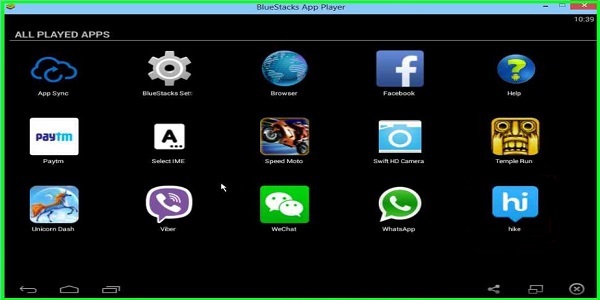- Best Android App Installer
- Android App Installer Windows 10 Sur Windows 7
- Installer App Android Sur Windows 10
- Android App Installer Download
- Install Android Apps On Windows 10 Desktop
Running Android apps on Windows 10 or 7 Pc is not a big deal at all, you just need right kind of Android emulator software. With strong foothold of Android smartphone in the market, each and every big company has its product app on Google play along with hundreds of useful applications that are not even available in the form of alternative for Windows PC. In such a situation, people keep looking for the best way to run Android apps of Windows 10/7 OS in order to play android games on PC or to increase productivity.
As I aforementioned in the beginning as it is possible using Windows 10 Android emulator, now the question arises which one should you use? Although there are a couple of best android emulators available in the market such as Bluestack, NoxPlayer and MEmu. These there best in their class. However, the oldest one is Bluestack which essentially more popular than the other two. So, here we are going the use Bluestack to install Android apps and the process would be more or less the same for MEmu and NoxPlayer Android emulators too.
Best Android App Installer

- Run the app on your Windows 10 PC. Enable Developer Mode and Device discovery on your Windows 10 Mobile Device. Connect your phone to PC using USB. Pair the app. You can now simply deploy the APK to your Windows Phone.
- Home; Features; Screenshots; Downloads; APKs; USB Drivers; FAQs; APK Installer for Android. Updated: Oct 15, 2018 Requires: Android 4.0 or higher License: Free File.
- Download the APK Deployment app. Run the app on your Windows 10 PC. Enable Developer Mode and Device discovery on your Windows 10 Mobile Device. Connect your phone to PC using USB. Pair the official app. You can now simply deploy the APK to your Windows Phone.
Step 1: Download Bluestack
Before installing Android apps on Windows 1o/7, we need to setup Bluestack first, for that visit its official website and download the agent setup; which later on PC, you need to run for downloading full Bluestack setup and installation. The latest version of Android is based on while writing the article was Android Nougat.
Step 2: Run Bluestack and Sign in to Google Play
Once the installation has done, you will get the Google Play store app asking to sing in. Click on Sign in button and use your Google account.
Step 3: Install Android Apps
Now, the Google Play store has been successfully set up, its time to download some Android apps on Bluestack running on Windows 10. The process is as same as we doing on our smartphone, in the search box type some app name, for example, Snapchat, Whatsapp, Instagram, Pubg etc.
Apr 21, 2017 BlueStacks App Player. If your PC has a touch screen, you can still use apps and games that rely on more than one touch input. BlueStacks can essentially make a Windows tablet PC into a part-time Android tablet. BlueStacks calls the technology that makes this possible “LayerCake” because Android apps run in a layer on top of Windows.

When you got the Android app you want to install and run on Windows 10 or 7, simply click on that and thereafter on respective Install button.
Note: SnapChat has been banned by its developers to run on Android Emulators due to the persistently crashing of app. Thus, even though we can install it on Bluestack, it will not run at all and keep the poping message that “try again later”.
Step 4: Run Android apps on Windows 10/7 pc
Android App Installer Windows 10 Sur Windows 7
Finally, the Android app you are up to if you have followed the above steps would have been installed, now. Its time to run it. Click on the Home Tab of the blue stack and click on the app you have installed., For example, we used Bluestack to run the Android Instagram app, so we click on that.
Installer App Android Sur Windows 10
According to the App, the Blustack adapts the screen size.
Android App Installer Download
In this way, we can run Android apps on Windows 10, Windows 8/7 using Bluestack or other Android emulators NoxPlayer and MEmu.
Install Android Apps On Windows 10 Desktop
Language supported
English (United States)English (United Kingdom)
Afrikaans (Suid-Afrika)
አማርኛ (ኢትዮጵያ)
العربية (المملكة العربية السعودية)
Azərbaycan Dili (Azərbaycan)
Беларуская (Беларусь)
Български (България)
বাংলা (বাংলাদেশ)
Català (Català)
Čeština (Česká Republika)
Dansk (Danmark)
Deutsch (Deutschland)
Ελληνικά (Ελλάδα)
Español (España, Alfabetización Internacional)
Español (México)
Eesti (Eesti)
Euskara (Euskara)
فارسى (ایران)
Suomi (Suomi)
Filipino (Pilipinas)
Français (Canada)
Français (France)
Galego (Galego)
Hausa (Najeriya)
עברית (ישראל)
हिंदी (भारत)
Hrvatski (Hrvatska)
Magyar (Magyarország)
Indonesia (Indonesia)
Íslenska (Ísland)
Italiano (Italia)
日本語 (日本)
Қазақ Тілі (Қазақстан)
ភាសាខ្មែរ (កម្ពុជា)
ಕನ್ನಡ (ಭಾರತ)
한국어(대한민국)
ລາວ (ລາວ)
Lietuvių (Lietuva)
Latviešu (Latvija)
Македонски (Република Македонија)
മലയാളം (ഇന്ത്യ)
Bahasa Melayu (Malaysia)
Norsk Bokmål (Norge)
Nederlands (Nederland)
Polski (Polska)
Português (Brasil)
Português (Portugal)
Română (România)
Русский (Россия)
Slovenčina (Slovensko)
Slovenščina (Slovenija)
Shqip (Shqipëri)
Srpski (Srbija)
Svenska (Sverige)
Kiswahili (Kenya)
தமிழ் (இந்தியா)
తెలుగు (భారత దేశం)
ไทย (ไทย)
Türkçe (Türkiye)
Українська (Україна)
O‘Zbek (Oʻzbekiston)
Tiếng Việt (Việt Nam)
中文(中国)
中文(台灣)